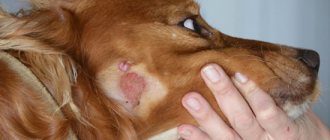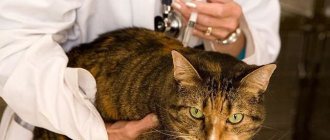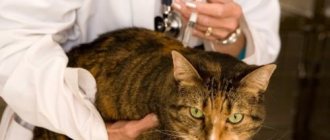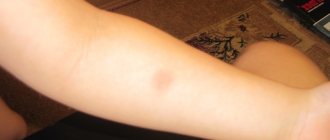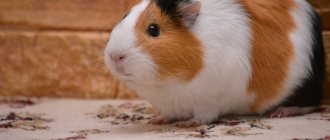Breeding rabbits is a very troublesome task, which requires mandatory vaccination of these animals against diseases that are fatal to their body. This is due to the increased risk of death of family members from seemingly trivial infections. Veterinarians warn about the need to administer vaccines to rabbits that are kept on the street, as well as to decorative rabbits, because a number of factors can lead to infection with diseases: from insect bites, walking on the street, and to feeding fresh grass.
What harm do mosquitoes cause to rabbits?
Warm and sedentary, in confined spaces, the rabbit is a tasty and defenseless prey for mosquitoes, which are able to bite the animal before shock sets in. Exposed areas of the skin, such as the ears and eyelids, are especially affected. However, a mosquito is able to get through the fur with its proboscis.
The consequences of massive rabbit bites by insects can be as follows:
- the animal loses its appetite and, as a result, its weight decreases;
- scratches appear on the body (especially around the eyes and ears), which the rabbit inflicts on itself with its paws in an attempt to relieve the unbearable itching after being bitten;
- the overall productivity of the farm drops noticeably - worried pets in a state of stress stop giving birth;
- intoxication of the body after a large number of bites can lead to shock and subsequent death of the animal;
- there is a possibility of infection with infectious diseases carried by insects, for example, myxomatosis, which from one infected rabbit can spread to the entire farm population and destroy it.
When raising rabbits, you may encounter the following problems: a rabbit chews a wooden cage, rabbits die, rabbits become obese, rabbits are born dead, rabbits have seizures, a mother rabbit abandons her babies, the rabbit loses its fur.
Popular polyvaccines for rabbits
Of all the combinations of complex vaccinations, the most common are bivalent ones against myxomatosis and hemorrhagic disease. The most popular drugs in this regard are:
- "Rabbivac V", which is produced in Russia;
- "Pistorin Mormyx", Czech production;
- "Lapimun Hemix", produced in Ukraine.
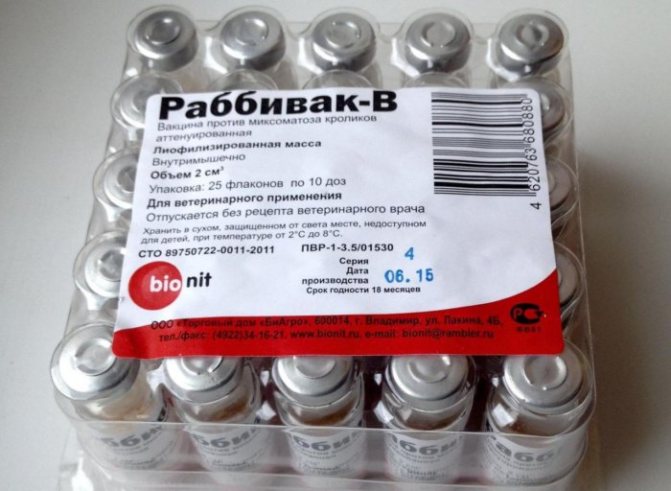
"Rabbiwak V"
The medicine Nobivak Myxo-RHD is also in demand among breeders. It is produced by one of the branches of the Dutch pharmaceutical company MSD Animal Health, which is located in Russia.
These drugs are sold in packages containing two bottles. Before use, the contents of each of them are mixed and only after that the animals are introduced.
Immunization of rabbits against colibacillosis, salmonellosis, klebsiosis and other diseases of a bacterial nature is carried out by vaccination with the OKZ vaccine. This inactivated vaccine creates stable and long-lasting immunity to the pathogens of these diseases.
But when using such means, it is worth remembering that each of the vaccinations does not imply one hundred percent prevention of the development of the disease. It only helps to strengthen the animal’s immune response, thereby significantly increasing its protection and effectiveness in fighting infection.
Features of the virus
Myxomatosis was first described at the end of the 19th century. The disease was observed in Uruguay in rabbits imported there from Europe. The spread of the virus to other continents began half a century later. It was brought to Australia specifically for the purpose of exterminating and limiting the uncontrolled growth of the rabbit population, which had no natural enemies in nature and caused huge losses to farmers. In the 80s of the last century, the virus reached European countries, including the USSR - outbreaks of the disease were noted in Russia, Belarus, and Ukraine.
The causative agent of myxomatosis is highly resistant in the external environment: it can survive in animal corpses for a week, in skins dried at a temperature of 70 ℃ for several hours, and at 20 ℃ for several months. The frozen virus remains active for two or more years. This is why frozen meat and uncured skins obtained from infected animals pose a great danger to other rabbits.
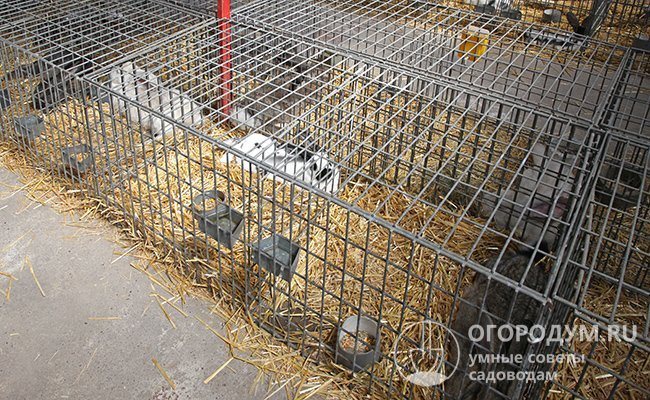
The causative agent of myxomatosis is similar to the smallpox virus, affects exclusively rabbits and threatens the loss of the entire livestock
The virus is also resistant to a wide pH range. It can be destroyed by heating at temperatures above 60 ℃ for an hour. A 3% solution of formaldehyde and caustic alkali, trypsin, ether and formalin are capable of inactivating the pathogen.
Distribution routes
Today, myxomatosis is considered a major infectious disease that has a direct impact on the rabbit population.
The virus is spread mainly by blood-sucking parasites : mosquitoes, lice, fleas. It is localized in the salivary glands of insects, where it can remain active for a long time (a rabbit flea remains a carrier of infection for more than 100 days, a mosquito for 7 months), and through bites it enters the blood of animals.
The pathogen can be transmitted through direct contact from an infected individual to healthy individuals, through household items, and also by some species of waterfowl.
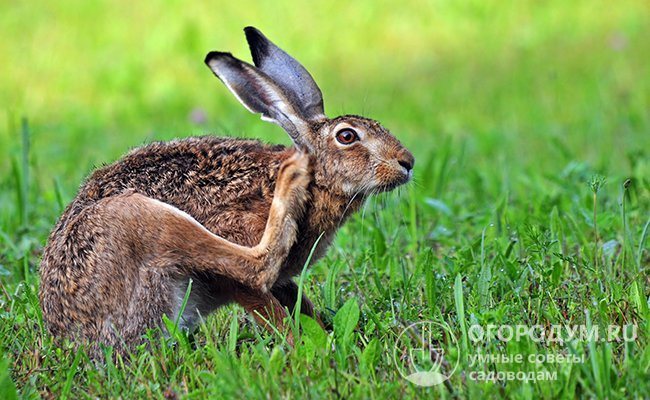
Wild hares are less susceptible to the disease, but are often carriers of myxomatosis in nature
All breeds of rabbits are susceptible to the virus . In affected individuals it is found in the blood, skin, subcutaneous tissue, and parenchymal organs.
At what age are rabbits vaccinated?
Rabbits should be vaccinated regardless of breed. When vaccinating, the age of the animals is very important so that stable immunity, a specific immune reaction of the body, is formed. Rabbits are very susceptible to stress, and as we know, stressful situations greatly weaken the immune system of animals.
For preventive immunizations in veterinary practice, complex (polyvaccines) and monovalent preparations are used. Vaccines can be live or dead (inactivated). Killed immunization preparations provide longer lasting immunity. Complex - divalent and trivalent provide protection against several infections simultaneously. Immune protection is formed in the same way as after the introduction of a monovaccine.
If you decide to vaccinate your pet against two diseases with mono-vaccines, the interval between injections should be at least 2 weeks. Otherwise, complications may arise due to drug incompatibility. It is strictly forbidden to mix different vaccines in one syringe. For subsequent revaccinations, it is worth using veterinary medications from the same manufacturer, unless, of course, the pet exhibits adverse symptoms after immunization.
The first vaccination against infectious diseases is given to rabbits at the age of 1.5 months. Until this moment, babies receive protective antibodies with the milk of their mother rabbit. It is best to wean rabbits from their mother at the age of 3 months, and it should be taken into account that after being separated from their mother, animals’ immune protection remains for 30–33 days.
Rabbits can be vaccinated against infectious diseases starting at 1.5 months of age.
Important! Vaccination of rabbits against myxomatosis and VGBV is mandatory, even in regions favorable for these infections.
If necessary, in unfavorable epizootological conditions, preventive vaccination should be carried out on animals at three weeks of age. Vaccinations against VGBV are given to rabbits at the age of 30 days.
Routine vaccinations take place at intervals of 6 months. The timing, vaccination schedule, veterinary medications, and an effective remedy are selected by the veterinarian.
Important! Only clinically healthy individuals with a body weight of 500 grams or more are allowed for preventive immunization and vaccination. If the animal has noticeable manifestations of diseases, the rabbit can be vaccinated only after the condition has normalized.
Healthy rabbits weighing over 500 grams are allowed for immunization.
Vaccines contain weakened viruses and bacteria.
After an injection or intramuscular administration of the drug, the body actively produces protective antibodies and develops a specific immune defense. Having experience and knowing what drugs are used for immunization, you can vaccinate animals yourself.
Symptoms of myxomatosis in rabbits
The incubation period (the time from the virus entering the body to the appearance of the first symptoms) ranges from 3 to 11 days, rarely reaching 20 days. Experts distinguish two forms of the disease:
- classical, characterized by the occurrence of edema on the body;
- nodular (nodular), characterized by the appearance of limited tumors throughout the animal’s body.
The disease sometimes develops in a hyperacute form, when symptoms do not even have time to appear: the virus quickly affects almost the entire livestock and on the second or third day mass death of animals occurs.
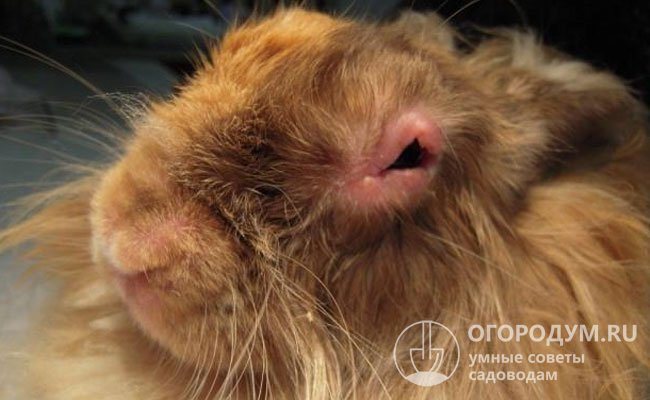
One of the first characteristic signs is inflammation of the mucous membrane of the eyes (conjunctivitis)
The classic course of the disease is characterized by the presence of certain symptoms that appear several days after infection. Most often observed in rabbits:
- refusal of food;
- catarrhal, later purulent conjunctivitis and blepharitis;
- discharge from the eyes and nose, first serous, then purulent;
- sticking of fur around the eyes, its subsequent loss;
- cyanosis of mucous membranes;
- increase in body temperature to 42 ℃ (normal – 38.5-39 ℃);
- swelling of the neck, dewlap, ears;
- swelling with a diameter of 2-4 cm (outwardly resembling dropsy) on the head, genitals, near the anus;
- rapid weight loss, blindness.
Sometimes the virus affects the respiratory tract. In this case, the animal begins to wheeze, and purulent discharge appears from the nasal passages. Often, infection causes signs of orchitis in males.
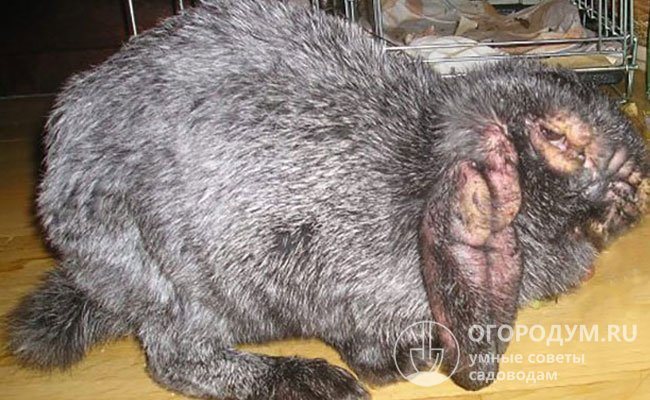
The ears droop, forming gelatinous swelling and folds, the head becomes like a lion's. This is where the popular name for the disease came from - “lion’s head”
In the chronic course of the disease, numerous nodules appear on the skin. This form is called nodular (nodular) and is most often found in young individuals. The mortality rate in this case is 50-70%, and the disease itself lasts from 30 to 40 days. Body temperature usually remains normal. The main symptoms are the appearance of red spots and small bumps on the skin of the ears, eyelids, nose, neck, paws, and around the claws. At the site of inflammation, around the 10th day of illness, foci of necrosis form, after which healing and recovery can begin.
Diagnostics
When making a diagnosis, specialists analyze the following data:
- season, availability of preventive measures (vaccinations);
- presence of characteristic symptoms;
- histological and biological studies in the laboratory.
Sometimes myxomatosis is confused with other diseases that have a similar clinical picture - staphylococcosis and fibromatosis. However, they are not characterized by high contagiousness and mass mortality of animals.
How to prepare a rabbit for vaccination
Rabbits do not need special preparation (diet, administration of additional medications) before vaccination. You just need to follow a number of rules, thanks to which all preventive measures will be successful:
- Carry out deworming of animals 2 weeks before the proposed vaccination.
- Examine the animals immediately before the procedure, check their body temperature (38-390C is considered the norm).
- Protect animals from stressful situations.
Is it possible to vaccinate a pregnant rabbit?
It is not recommended to vaccinate a pregnant female, since the drug can harm babies in the womb or cause premature birth. But if there is mass infection in the region, then it is possible to introduce a protective agent. For pregnant women, the same vaccines are used as for all other rabbits.
It is best to prevent all possible risks and vaccinate female rabbits before mating or the onset of pregnancy.
Vaccination of decorative rabbits
Decorative rabbits are vaccinated according to the same scheme and against the same pathologies as their relatives from farms. The main directions for carrying out protective procedures are the use of drugs against rabies, myxomatosis and VGBV.
Despite the fact that pets do not come into contact with the external environment, people, and sometimes even flies or fleas, can bring them the pathogen with equipment or food. Therefore, the only way to protect long-eared animals is a mandatory vaccination procedure. When vaccinating a dwarf rabbit yourself, you must strictly adhere to the dosage of the drug so as not to harm the animal.

Cell processing
They use folk remedies and professional preparations. The choice of method depends on the location of the rabbitry - indoors or outdoors.
Insecticides
The poison destroys existing mosquitoes and prevents the appearance of new ones. Concentrated preparations are used to disinfect premises. The solution is prepared immediately before disinfestation. Dissolve the amount of insecticide specified in the instructions in cold water, mix, and pour into a spray bottle.
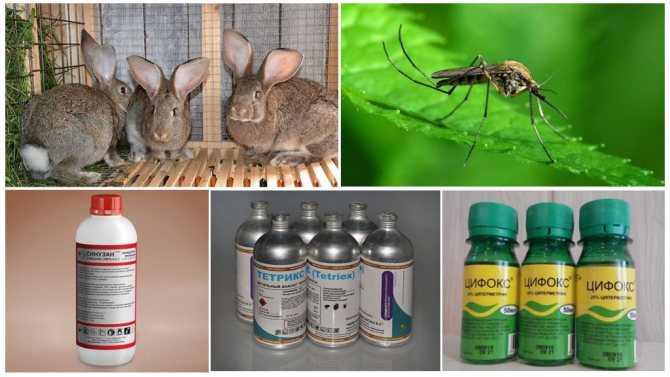
Means for treating rabbitry against mosquitoes
At the time of processing, there should be no animals or food in the room. All walls, ceilings, and window sills should be disinfected. After 2 hours, the bedding is changed, the cages are cleaned, and new food and water are provided. They ventilate well, only then let the rabbits back in. Protection lasts from 2 to 4 weeks, depending on the chosen product. Effective drugs - Sinuzan, Tetrix, Tsifox, Cypermethrin, Executioner, Get, Medilis Cyper. The average price of a professional product is about 300 rubles. per bottle with a capacity of 50 ml.
On a note!
Instead of concentrates, you can use special smoke bombs. The action is identical, but minimal human intervention is required. The poison is released into the air during the burning of the bomb, fills the entire room, and penetrates hard-to-reach places. Disinfestation time is 2 hours, after which the bomb fades out. After cleaning and thorough ventilation, you can release the animals.
The cost of one checker is 100-400 rubles, depending on the manufacturer. The products Quiet Evening, Fomor, Whirlwind, and Boy Scout can help get rid of mosquitoes in a rabbitry.
Folk remedies
Rabbits and mosquitoes exist side by side in warm, humid weather. Animals are not able to protect themselves from bloodsuckers on their own, so all responsibility falls on the shoulders of the owners. Insecticidal substances cannot always be used; they are not suitable for everyone due to their high toxicity, so many continue to fight with folk remedies.
- They lay them out on rabbit cages or hang bouquets of tansy and tobacco. Mosquitoes cannot tolerate the persistent smell of these plants and avoid cages with rabbits.
- Stagnant water is regularly removed, drinking bowls are washed daily, and bedding is removed in a timely manner. Mosquito larvae breed in stagnant water and humid environments.
- Rub the grates with garlic and place the arrows inside.
- A container is placed in the rabbitry and pieces of foam rubber soaked in kerosene are placed in it. The pungent smell will help save rabbits from mosquitoes and midges.
On a note!
The protection lasts as long as the smell is present, so you will have to update it very often. Mosquitoes finally disappear with the onset of persistent cold weather - below +10 degrees Celsius, around the end of September.
Self-vaccination
Vaccinating rabbits at home requires a lot of experience and knowledge. For the first time, it is advisable to have a veterinarian nearby. If this is not possible, the following rules should be followed:
Regarding medications:
- the purchase of drugs must be made in specialized pharmacies;
- It is mandatory to check expiration dates and quality certificates;
- the instructions for quality products indicate the dosage, timing of administration, revaccination and other useful information - they need to be carefully studied;
- transportation and storage of the medicine should occur within the range from +2 to +8 degrees;
- freezing will spoil the drug and its administration will be useless, so in winter the vaccine should be transported in a special box.
Vaccine dilution:
- after opening the vaccine, the shelf life is 3 hours;
- The drug in dry form must be diluted with clean distilled water or a special diluent (included with the vaccine).
IMPORTANT! The finished mixture is suitable for injection only for three hours.
Injection administration:
- optimal ambient temperature up to +28 degrees. In hotter weather, it will be difficult for the pet to cope with the administered drug;
- it is recommended to administer the suspension with a disposable syringe or an injector - a device for needle-free vaccination;
- vaccinations should be given in the thigh, withers or ear area - where to inject depends on the type of vaccine and the method of administration (intramuscular, intradermal or subcutaneous).
For novice farmers who are interested in rabbit farming, such procedures may seem quite complicated. Fixing an animal in a comfortable position brings many difficulties - not everyone succeeds in placing the pet correctly the first time. In such cases, you need to seek help.
How to protect rabbits outdoors
Mosquitoes bite much less often animals that live outside in well-ventilated cages. Provided that they are cleaned in a timely manner, the bright rays of the sun get inside. But in the evening the risk of being bitten remains.
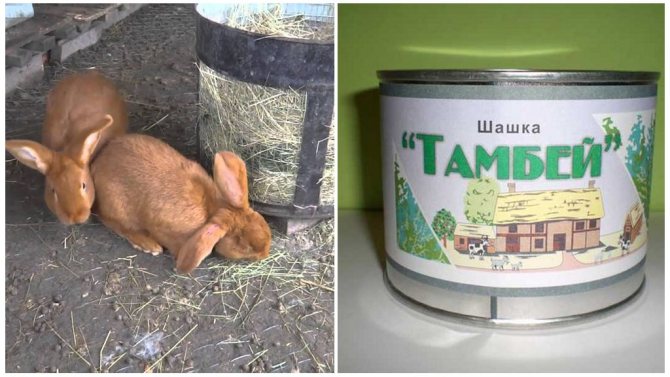
Tambay checker to protect rabbits from mosquitoes
Smoke bombs are used to clear the area of midges. Place in the direction of the wind 15 m from the cells. The best option is if the animals are transplanted to another place at the time of disinsection. The smoke is carried by the wind up to 15 m. The poison settles on the grass and tree leaves. Protection lasts from 20 to 60 days, depending on temperature conditions. Heavy rains wash away the poison.
- Tambay. Therapeutic and prophylactic drug. Used for disinsection of livestock buildings from viruses. But, since tansy is present in the composition, the product copes well with mosquitoes. Cost 340 rub.
- Vortex. Based on cypermethrin. The substance affects the nervous system of insects, leading to death. It enters the body through the respiratory tract, upon contact with a treated surface. One checker is enough to treat a room with an area of 650 square meters, and can be used outdoors. Price 200 rub.
- Biolarvicide. The biological product contains bacteria that infect mosquito larvae. Used for disinfestation of ponds and standing puddles. The maximum effect lasts 2 weeks. Price about 2300 rub.
In addition to checkers, the folk remedies described above are used. In this case, the protection is updated every evening.
How to vaccinate rabbits yourself
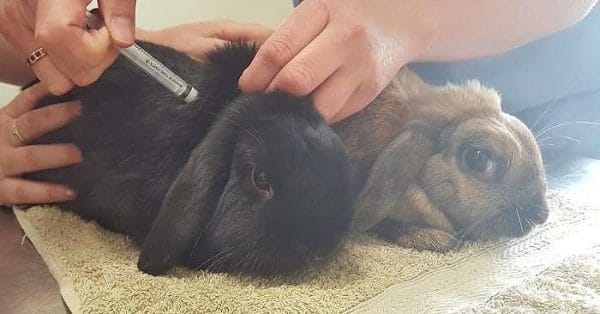
Experienced breeders prefer to vaccinate their pets themselves; it is cheaper, and the rabbit does not need to be taken to the clinic (especially when a whole herd is being vaccinated). Before the procedure, you need to take care of the drug itself. Purchase it from veterinary pharmacies or clinics.
It is important to ask the seller for a certificate and check the expiration date.
Vaccinate strictly according to instructions. The dry powder is diluted (solvent - water) to make 0.5 ml. The needle of the insulin syringe is wiped with alcohol (used once), as is the puncture site.
It is better to inject into the thigh - intramuscularly, but subcutaneously is allowed - into the fold on the withers (the skin is pulled back). A specific place is not selected; it is impossible to harm the animal in this way. The required dose is injected and the area is wiped with alcohol.
Attention! An open drug is used within 3 hours, after which the expiration date expires and the vials are disposed of.
Quarantine – 14 days. At this time, it is important to limit contact with unvaccinated individuals, reduce the risks of mosquito bites, and the influence of the external environment (cold, heat).

Be sure to read:
At what age are baby rabbits separated from their mother, what does it depend on, and what to feed them
To improve the functioning of the immune system, vitamin supplements, immunostimulants, fish oil, pumpkin, sprouted grains, and rowan are introduced.
If you plan to transport your pet across the border or participate in exhibitions, 20 days must pass after the last procedure, but no more than six months (for mandatory vaccines). The schedule is tracked using the veterinary passport.
Mosquito repellent for rabbits
To get rid of dangerous pests, you can treat the cells or the animals themselves. There are no special medications for rabbits, but medications for cats, dogs, and folk remedies are often used.
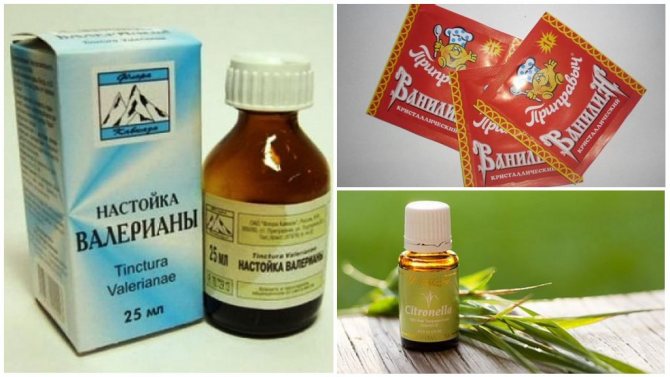
Folk remedies to repel insects
Folk repellents:
- Place a few drops of valerian on the fur. The smell is extremely persistent and lasts for about 2 days on the coat. The aroma does not bother rabbits, but repels mosquitoes for several meters.
- Dissolve a packet of vanillin in water, stir, and pour into a spray bottle. Spray animal hair with the product every evening during mosquito season.
- Add essential oils of citronella, lavender, mint, lemon balm, rosemary, cedar, and lemongrass to the water. The bottle is used to spray the wool. If it is not possible to prepare a spray, drop a few drops of any ether onto the wool.
- An infusion is prepared from tansy. Pour the potion with cold water, let it sit for a day, pour it into a bottle, and treat the rabbits and cage.
- Mosquitoes do not like the smell of tobacco. It is recommended to plant a plant next to the cells, lay out the leaves, or prepare a decoction. However, a tincture made from cigarette butts is more effective. Throw into water and leave to infuse for several hours. Used for spraying rabbit fur and cages.
- Prepare garlic tincture. Peel half a glass of cloves, fill with cold water, and leave for a day. Use the product to treat rabbits and their housing.
Professional repellents:
- It is allowed to use mosquito repellents for children - Gardex, Moskitol, Off, Picnic, Shoot mosquito. Spray onto the fur, avoiding the eyes and mouth. The protection lasts for 8 hours, so the treatment should be repeated every evening. If an allergic reaction occurs, the medications should be discontinued.
- Frontline is often used to protect rabbits in the form of drops or spray. Means for treating dogs and cats. Produced by a German and French company based on the modern insecticide fipronil. After application, the product accumulates on the rabbit's fur, bypassing the systemic bloodstream. Mosquitoes die after contact with the treated cover. Spray the entire rabbit coat with the spray. Drops are applied to the head, along the spine. There are no side effects as such. With individual intolerance, allergies, lacrimation, diarrhea, cramps, loss of appetite, etc. develop.
The main thing about vaccinations
Every owner who breeds rabbits for commercial purposes or keeps an ornamental animal as a pet must understand that all types of rabbits need vaccination . These animals are susceptible to various diseases, including those that are dangerous to humans. Of course, it is wiser to prevent a disease than to treat it later, especially since some of them cannot be treated at all.
Vaccines are designed to develop immunity in an animal to a particular pathogen. Occasionally, after the vaccination procedure, rabbits may experience symptoms of the disease, but the disease is mild, and the risk of contracting the same infection in the future is minimized.
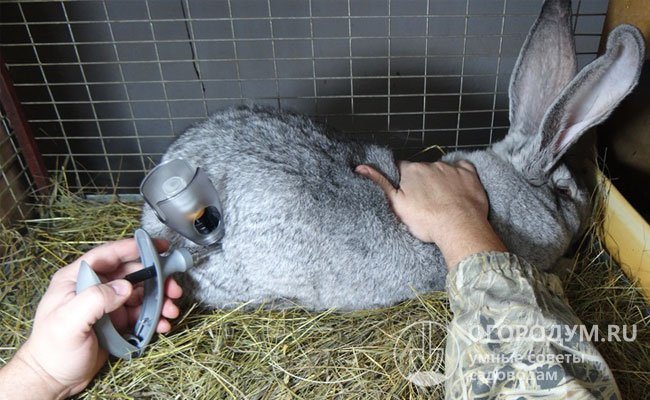
With a large population, it is most convenient to inject animals using a special automatic syringe
The causative agents of various infections are transmitted to rabbits through contact with each other and other animals, through insect bites, while walking, eating food and water. That is why even those pets who spend their entire lives in an apartment with caring owners are not insured against diseases.
Rabbits during pregnancy at different stages can also be vaccinated with any type of vaccine (inactivated multicomponent preparations are better), but it is more correct to immunize in advance. The only contraindication is the feeding period, since vaccination of the female can negatively affect the health of newborn cubs. If we are talking about breeding rabbits, then the necessary vaccinations should be done a couple of weeks before mating. Thanks to this, the animals will develop immunity to dangerous diseases, which will serve as protection for future rabbits.
Folk remedies
You can also protect your long-eared pets from mosquitoes without the help of complex instruments or devices. The old-fashioned methods are probably not so effective, but they really work and will help the rabbit breeder reduce the number of annoying insects to an optimal level. Mechanical protection is the first folk remedy.
The mesh works well, even though mosquitoes can also enter through the floor. All that is needed is to cover with nets those places through which harmful insects can fly to the rabbits. It should be remembered that gauze is not suitable as a protective screen, since not only mosquitoes, but also air will practically not be able to penetrate.
Why is vaccination necessary?
The main problem of rabbit breeding is that most diseases of these animals are practically untreatable. Pathologies such as myxomatosis or viral hemorrhagic disease lead to death in almost 100% of cases. In this case, only a few survive. In addition, there is always a threat of the spread of diseases and the development of an epidemic. Therefore, timely vaccinations often help preserve not only the health of animals, but also their lives.
Treating rabbits for mosquito bites
An animal suffering from mosquito bites itself shows the disease by its condition - it is too excited, constantly itches with its paws and hides in the corners of the cage. You can help your rabbit by treating the bitten areas. This is usually done with iodine, which, in addition to disinfection, will relieve local pain.
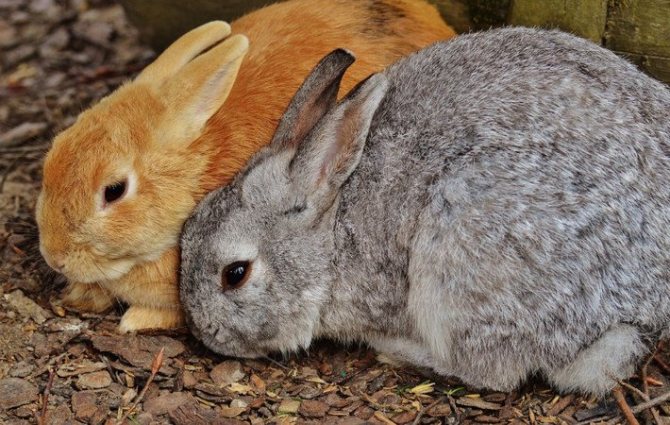
To relieve itching from your animal’s ears, it is better to contact a veterinary clinic, where they will professionally solve the problem.
Important! If the rabbit managed to scratch the mosquito bite, this area should be treated with brilliant green. This way the wound is treated and infection is avoided.
Treatment of swelling from bites can also be carried out with special liquids based on soda solution. A teaspoon of soda is added to a glass of warm water - the soda solution is ready. The injured rabbit may also be moved to an air conditioner where the animal can calm down.
In difficult cases, a rabbit bitten by mosquitoes is given antihistamines, which will not only help against bites, but also protect against myxomatosis - a disease that is the scourge of this pet.
Mosquito attacks greatly affect the health of rabbits. The farmer needs to solve this problem immediately, because these pets are extremely susceptible to the bites of bloodthirsty insects.
Was this article helpful? Thank you for your opinion! Write in the comments what questions you have not received an answer to, we will definitely respond! You can recommend the article to your friends! You can recommend the article to your friends! YesNo 45 times already helped Animal husbandry Rabbits Keeping rabbits Problems in keeping rabbits No comments Add a comment <textarea name= "Comment[text]" placeholder="Comment text"> Leave a comment You might like Which pigs are meat: getting to know the most productive breedsAre milking machines good for cows? Cattle parainfluenza-3 Udder diseases in cows Feed additives for cattle How to cure a sick one bovine fascioliasis Anthrax in cowsCan a dairy cow be given potatoes? Structure and diseases of the limbs of horses
- Discussed Crimean ironweed, shepherd tea, Tatar tea, and Crimean lemongrass, four names - one benefit How to fertilize grain crops: application rates Secrets of successfully growing chili peppers on a windowsill How to use Baykoks for chickens: instructions for use Useful properties of periwinkle: use in traditional and folk medicine and contraindications Wormwood species, or what kind of wormwood there is Eucharis flower: care, replanting and propagation at home Is it possible for gardeners to use the fungicide “DNOC”
- Popular reading A shortage of consumer interest has been registered on the feeder market World 100 thousand farm animals lost in Australian forest fires World In Transcarpathia, garlic is revitalized with heat Ukraine Without land and farmers - the agricultural revolution in Japan World Lunar sowing calendar for December 2021 Lunar calendar US Farmers advocate support for continued funding Peace Provincial meat inspectors prepare to work in priority plants Peace Spain's horticulture sector requires labor Peace
Types of vaccines and their properties
There are several types of vaccines, among which live or inactivated groups are distinguished. Live ones give faster results, but are poorly tolerated by animals. Inactivated ones are more reliable and contribute to long-term preservation of immunity.
In turn, inactivated vaccines are divided into single vaccines and complex varieties. The first types are intended to improve immunity and resist one pathology dangerous to health, while the complex ones are for everyone at once.
Mono-vaccines
Mono-vaccines do not differ in properties from complex vaccinations, but are intended to prevent a specific disease. The following serums are distinguished:
- against the development of myxomatosis, it is recommended to inject “Rabbivac-V”, “V-82”, “Lapimun Mix”, Myxoren (Czech drug);
- against viral hemorrhagic disease: “Rabbivac-V”, “Lapimun Gem”;
- against pasteurellosis (and infection with other parasites) - “Rabbivac-R” or Pasorin-OL.
It is better to inject the first vaccine in a veterinary clinic or by inviting a veterinarian to your home, who will first assess the condition of the rabbits and determine whether they can be injected with serum at the moment. Often weakened individuals are placed in a separate cage and given additional time for the first vaccine.
Complex serums
Complex vaccines are offered by manufacturers in two vials, which must first be mixed according to the instructions. The list of the most popular and effective serums includes the following:
- "Nobivak Muho-RHO";
- "Rabbiwak VB";
- "Lagimun Hemix" and others.
See also How to treat conjunctivitis in rabbits at home?
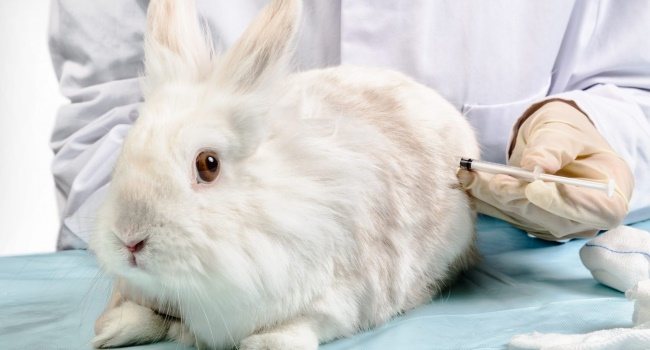
For further prevention, which is carried out every year or every six months, it is recommended to use the drug “OKZ Vaccine” produced in Ukraine. This serum allows you to protect the body not only from diseases, but also from numerous parasites.
Prevention
In order not to observe sick rabbits in pens, it is worth following a few simple rules that will help maintain a healthy population, namely:
- vaccinate all rabbits annually;
- in order not to expose animals to disease, it is necessary to clean the cages in which rabbits live daily, and also thoroughly wash all feeders and drinkers;
- once a week, disinfect all places where your pets live;
- the entire area adjacent to the rabbitry must also be regularly processed;
- monitor the quality of their diet and try to ensure that all the food that goes to the rabbits is nutritious, healthy and always fresh;
- exclude contacts of your livestock with people unfamiliar to them, because in some cases people can infect the eared ones;
- It is recommended that each rabbit be regularly inspected for insect parasites.
These simple rules will help prevent diseases in your furry pets. And, of course, don’t forget to get vaccinated. Together, such measures will help protect the livestock from myxomatosis.
If you are planning to breed rabbits, then take this activity very seriously. It is important to understand that these animals are very fragile and require a lot of time and effort in the raising process.
But for such painstaking work you will definitely be rewarded with luxurious fur and one of the most tender and delicious types of meat.
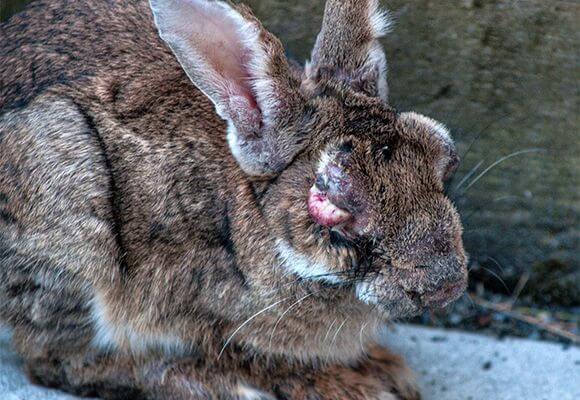
Mandatory vaccinations
It is recommended that rabbits be vaccinated against the following pathologies:
- myxomatosis;
- rabies;
- viral hemorrhagic disease.
Rabbits are more susceptible to these pathologies. However, animals can become infected anywhere. This is possible in the following cases:
- contacts with animals that spread infections - these include rats and mice;
- violation of conditions of detention;
- insect bites.
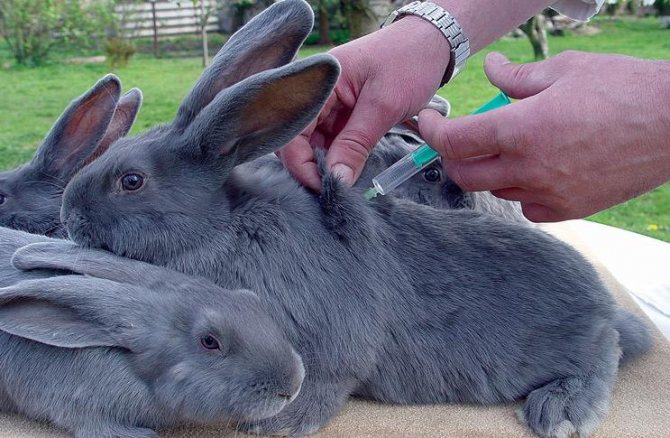
The threat of infections lies in the fact that when a disease is detected in one rabbit, it quickly affects all the others. It is permissible to do the vaccination yourself. To do this, it is not at all necessary to contact a veterinarian. It is important to take into account that only healthy animals with normal temperature are allowed to vaccinate.
Recommendations and tips
The recovered animals cannot be used for meat for some time, as they were injected with veterinary drugs. If antibiotic therapy was used, slaughter is allowed only 2 weeks after treatment.
Often, rabbit breeders also have the following questions when dealing with rabbit disease myxomatosis:
- Is it possible to eat the meat of a sick animal;
- how to dispose of carcasses;
- Is it possible to give infected carcasses to domestic animals;
- Can a person become infected by cutting up the carcasses of sick rabbits?
Do not feed rabbits that have died from myxomatosis to domestic animals. The possibility of transmitting the poxyvirus to other animals cannot be completely ruled out. In addition, the carcass contains medications that were used to treat the sick animal during its lifetime.
Is it possible to eat contaminated meat?
Rabbit meat infected with myxomatosis can be eaten if it has been boiled or stewed for at least 2 hours. The meat of an animal that was forcedly killed at the earliest stage of the disease is allowed to be eaten.
If a rabbit has died from myxomatosis, it should not be used for cooking. Although the virus is safe for humans and dies at a temperature of 55°C in 25 minutes, it changes the normal metabolism in the animal’s muscles.
In addition, repulsive-looking bruises, gelatinous swellings, and disgusting nodules are found on the tissues of the carcass of a sick animal.
How to dispose of carcasses
Dead animals and their bedding are burned. It is also necessary to destroy leftover food and low-value equipment.
To stop the spread of the disease, the destruction of infected animals and equipment is carried out in a specially designated place. Delivery to the site and destruction of carcasses is carried out under the supervision of a veterinarian.
Is it possible to get myxomatosis?
The virus that causes myxomatosis in rabbits is not dangerous to humans. A person cannot become infected from a rabbit himself and is not able to infect other people with this disease.
But upon contact with an infected animal, nursery workers’ hands and clothes will become contaminated. In this case, a person becomes a carrier of infection and is able to infect healthy animals.
Sources
- https://privivkumne.ru/zhivotnym/privivki-krolikam.html
- https://agronomu.com/bok/7782-kak-obezopasit-krolikov-ot-komarov.html
- https://ogorodum.ru/miksomatoz-u-krolikov.html
- https://notklop.ru/komary/o-komarah/kak-zashchitit-krolikov-ot-komarov/
- https://otvet4ik.info/spasti-krolikov-komarov-ulitse-krolchatnike/
- https://MojaFerma.ru/zhivotnovodstvo/kroliki/miksomatoz.html
- https://dacha.one/zhivotnye/bolezni/miksomatoz
Vaccinations for pregnant rabbits
Doctors recommend vaccinating the female 2 weeks before mating. This way she will develop immunity to certain viruses, pass some of it on to future offspring, and the young will be born primarily protected. But vaccination during pregnancy in the absence of allergies is well tolerated.
Important! Vaccination is carried out at any stage of a rabbit’s life; the procedure is undesirable only during lactation (milk may turn sour, disappear or run out).




